If FCC Can't or Won't Deal with FM Pirates, Perhaps It Should Have a Candid Conversation With FAA on Aviation Safety?
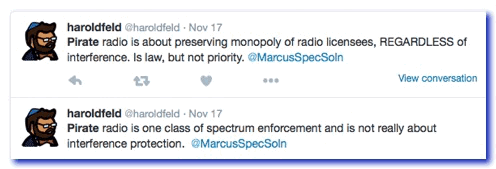
I have known Harold Feld, Public Knowledge's Senior Vice President, for a long time and agree with him on many issues. He has even been a past client. But the above Twitter exchange indicates a not unusual viewpoint in the spectrum policy area and clearly was an undercurrent in the recent consultant's report that rationalized decimating the FCC's spectrum enforcement resources.
Notwithstanding vague promises made to NAB it is pretty clear that broadcast pirate enforcement will be a low priority for the new "modernized" field enforcement at FCC. Pirate broadcasting is often intermittent and at odd hours, requiring both staff overtime and travel, two things that are very scarce at today's underfunded FCC. New equipment designed to decrease necessary staff time would also be helpful, but equipment money is also very scarce.
So let me address the safety implications of pirate broadcasting, rather than view it solely as just an economic inconvenience to incumbent broadcasters. Pirate broadcasters distract audiences and also sometimes even carry paid ads!
But all properly licensed FM stations are subject to technical rules also. While some of them may be about "preserving monopoly of radio licensees", many also deal with preventing interference to other non broadcast radio systems. (The ongoing saga of interference from certain licensed FM stations to 700 MHz LTE base stations due to a regulatory loophole (along with FCC distraction on other issues) is a concrete example that each radio service does not live in a totally independent silo from other services!
It is doubtful that all pirate FM stations buy transmitters that meet all Part 73 technical standards with respect to out-of-band emissions and harmonics. Thus there is a real risk of interference to other radio services without some reasonable check and balances.
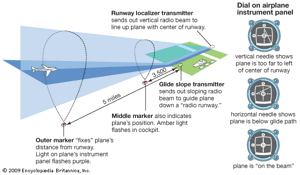
FM stations that are properly licensed use frequencies, powers, and locations that have been reviewed by FAA during the application process to make sure they do not pose a new inference risk to ILS receivers in aircraft. Pirate radios are very unlikely to check with FAA. (FAA's Airspace Analysis Model computer program that does the analysis is publicly available so they might check, but I doubt it.) While it is generally assumed that intermodulation interference can only occur when there are 2 strong signals present with the correct mathematical relationship with the victim signal, that is not literally correct. As shown in ITU-R Recommendation SM.1009-1 the interference power generated in the receiver by the inevitable nonlinearities is the weighted sum of the power of the 2 FM frequencies that have the correct relationship with the ILS frequency. (This is called Type B interference in the jargon of ITU-R.)
If one of these FM broadcast band frequencies comes from full power FM station and is very large at the location of the ILS receiver in the air, only a negligible amount of power at the other frequency is needed to cause interference if they have a certain mathematical relationship. While the math is clear, it is counterintuitive that a low power signal could cause such interference. Many years ago while I was working at FCC on this issue and the main contact with FAA on it I asked them to demonstrate this phenomenon which they kindly did for me and several other FCC officials at their Technical Center in Atlantic City.
Thus a modest power pirate FM could have the right location, power, and frequencies to cause Type B interference to the safety critical ILS signal.
Like FCC, FAA is not a perfect agency. Almost every other aviation regulator in the world limits the likelihood of this interference by both addressing the issue of FM station power, frequency, and location near airports and by mandating receiver immunity standards prescribed in ICAO Annex 10 to the Convention on International Civil Aviation, Volume I – Radio Navigation Aids, Section 3.1.4 Interference immunity performance for ILS localizer receiving systems (2006). However, as we have discussed earlier, FAA has refused to implement their standards for US aircraft in domestic service and has blocked FCC implementation of them. Thus the FAA's Airspace Analysis Model that predicts interference assumes that receivers more vulnerable than the ICAO standards are in use. But as pirate radio stations proliferate without effective enforcement there is a real risk that one of them might just land at a power, frequency, location triple that poses a threat to aviation safety but is not addressed since pirates don't have to deal with spectrum regulations!
If this is the new reality of "field modernization" then I urge FCC to have a pragmatic discussion with FAA,who were consulted on aspects of the consultants study but probably not this one, that FM pirates are a low priority and they might want to increate the immunity of the US air fleet (foreign aircraft already comply) to this type of interference by implementing the 2006 ICAO immunity standard.
FCC Technological Advisory Council: Why Is It Having a Meeting in the Middle of the Major Communications Technology Conference?
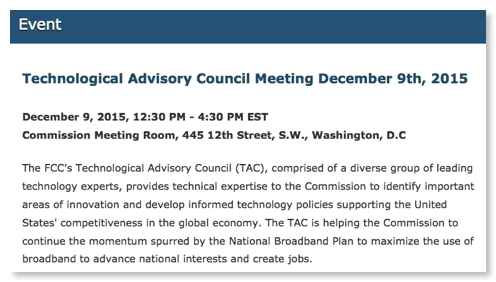
The above announcement appears on the FCC's website yesterday. I looked at it and said to myself "Isn't something else going on in the communications technology area that week?" Oh, Yes!

This is the major communications technology conference in the USA and covers a wide variety of specialties, unlike the NAB and CTIA conventions dealing with specific industries that are a "must go" for all FCC commissioners and most senior managers. But Globecomm is also the only major technical conference to attract a sitting FCC commissioner in recent years: Comm Rosenworcel spoke in 2013 saying:
"It is a treat to be able to join you because the IEEE Communications Society is an important force in the innovation economy. You are working on some of the most cutting-edge issues in communications from the development of LTE and dynamic spectrum access to the coming Internet of Things. Plus, the work you do supports our work at the Federal Communications Commission. But it has been too long since a Commissioner has visited with you for this conference. So I decided it was time and made the trek to Atlanta today."
The FCC’s Technological Advisory Council is described on the FCC website as follows:
The FCC’s Technological Advisory Council (TAC) provides technical advice to the FCC. The TAC is organized under the authority of the Federal Advisory Committee Act. The current TAC, which is the FCC’s 5th Technological Advisory Council, was formed on October 21, 2010. The TAC is comprised of a diverse array of leading experts that helps the FCC identify important areas of innovation and develop informed technology policies supporting America’s competitiveness and job creation in the global economy.
Sp why are few, if any of the TAC's "diverse array of leading experts" attending the country's major communications technology conference? Perhaps look at the list of members. Many are indeed distinguished such as cell phone pioneer Marty Cooper who has both the major peer recognition for techies: Marty is both an IEEE Fellow and a member of the National Academy of Engineering. But how many of the TAC members have either of these major peer recognitions? Such peer honors are not the only recognition of being a skilled expert, for example younger superstars tend not to be recognized quickly as both programs focus more on sustained achievement. But I don't think that is the reason that most TAC members have neither honor.
When FCC originally formed the TAC around 2000 it had a choice under the Federal Advisory Committee Act of either a group representing specific entities or a group of independent technical experts without conflicts of interests. In the first case the members did not have to be paid for either their time or expenses. In the perpetually under budgeted FCC this was appealing and it is why the table of TAC members clearly has a column labelled "Representing" that shows which entity each member presents. Thus Microsoft, Cisco, AT&T, Comcast, CEA/CTA, Google, Amazon, Qualcomm, Facebook, Motorola, Time-Warner, and Verizon all have their "representatives". But it is for this very reason that FCC can not ask its TAC key technical policy issues analogous to one that NRC, EPA, and FDA can ask their technical advisory committees: the membership have hopeless conflicts of interests and can only deal with generalities.
So you got no TAC input on GPS/LightSquared and don't expect any on the complex Wi-Fi/LTE-U controversy or even on how to solve ongoing stubborn interference problems such as the recurring interference to 700 MHz LTE base stations from FM broadcast station harmonics that both FCC and CTIA are trying to "sweep under the carpet" to avoid distractions to the incentive auction.
The current TAC performs a genuinely useful function, but it is not its purported function! it efficiently collected the viewpoints of major regulatees to key long term policy issues. But is it not helping FCC address its major spectrum policy decision throughput shortfall because, as now structured, it can't address most issues.
The IEEE-USA recommendations to FCC for improving spectrum policy urged the following:
FCC and NTIA should supplement their existing Technological Advisory Council (TAC) and Commerce Spectrum Management Advisory Committee (CSMAC), which consist mainly of representatives of major communications firms, with a new advisory committee that serves both agencies and focuses on independent review of options for resolving spectrum conflicts and identifying outdated policies. The new group should be modeled on the EPA Science Advisory Board and the NRC Advisory Committee on Reactor Safeguards and members should have the necessary security clearances to deal with issues involving classified federal government spectrum users, if so requested.
While this option would cost money, sharing a purely technical committee between FCC and NTIA would spread the costs and let the leadership of both agencies get both the best techies and independent timely option for resolving complex spectrum policy issues. I also suspect such a joint committee would not schedule meetings during major technical conference, because many of its members would be attending.
House Oversight Hearing
New EB Field Chief Announced in Low Key Way

Last Friday, Broadcasting & Cable's veteran reporter and Washington Bureau Chief John Eggerton posted an article entitled "FCC Names First Enforcement Bureau Field Director". The article begins:

FCC Enforcement Bureau Chief Travis LeBlanc announced Friday in an internal e-mail to staff that he plans to appoint the FCC's first ever Enforcement Bureau field director, Charles Cooper. Cooper comes from engineering consulting firm du Treil, Lundin & Rackley, where he was a partner and senior engineer.
Charles Cooper (2011)
Previously EB had announced that spectrum users with unresolved complaints "may contact the Field Director within 2 weeks after the period for the initial response". But only a few industry insiders were told who the acting field director was! (Actually it was also Mr. Cooper.) The policy also stated "Complainant may contact the relevant Regional Director within 1 week after the period for the initial response". For many years after EB was formed in the early 1980s from the former Field Operations Bureau, briefly renamed Compliance and Information Bureau, the phone numbers and e-mail addresses of field enforcement officials outside the Beltway were a closely held secret (even to non-EB FCC staffers) as all public contact was directed to the Call Center in Gettysburg. That changed a few years ago, but such contact information is really buried in the FCC's voluminous poorly organized web site. It certainly is not directly reachable from EB's home page.
Today, several days after the internal announcement and Mr. Eggerton's publication of the news and similar announcements in other publications, there is no word of this new appointment anywhere on the FCC or EB's website!
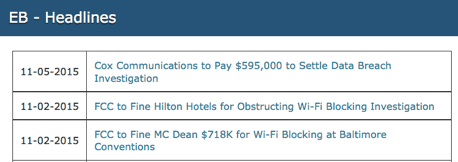
Headlines from EB homepage 11/17/15 10 AM
But does any of this surprise us when FCC never bothered to announce in 2013 that 2 senior official were getting the Presidential Rank Awards, a federal government-wide great honor for senior civil servants that had only been awarded 2 other times since 1978 to FCC staffers. So if the FCC has a million dollars to spend on consultants, perhaps they might also want to hire a consultant on how to motivate their staff more effectively by recognizing their accomplishments?
Here is a bio of Mr. Cooper dating to when he joined FCC a few years ago:
Prior to joining the FCC, Mr. Cooper has most recently been a Senior Engineer and Partner at the engineering consulting firm du Treil, Lundin & Rackley, where for twenty years he focused his engineering talents and expertise on communications issues and gained more than thirteen years of management experience. He is a Registered Professional Engineer, a former member of the Mississippi Air National Guard and Reservist, and a Cum Laude graduate of Mississippi State University. Mr. Cooper has performed and supervised many different types of communications projects including those in all of the broadcast services (AM/FM/TV/DTV). He also has experience inwireless, point-to-point microwave and land-mobile. He has served twice as president of the Association of Federal Communications Consulting Engineers.
Congratulations to Mr. Cooper on this appointment and our best wishes for success. Hopefully he can convince FCC leadership to give him the needed mix of personnel resources, overtime, travel funding, and equipment funding needed to do this key job. It would not hurt if key industry trade associations ask FCC leadership about the flow of resources to the remaining EB spectrum enforcement operation. Indeed, they might also want to talk to OMB and the congressional appropriation committees about the importance of adequate spectrum enforcement resources for their billions of dollars worth of Title III licenses.
Spectrum Enforcement Downsizing Report has Leaked Out
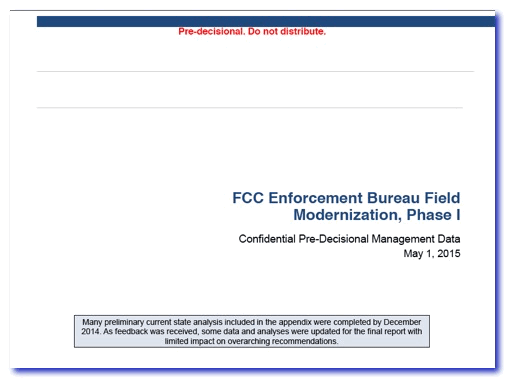
The consultant's report that was used to rationalize the downsizing or decimation of the FCC's spectrum enforcement field staff has now leaked out. I previously filed a FOIA request for this. EB's response that did not produce even a word of the text due to total stonewalling. Of course this is the same EB that in the previously discussed case of the Motorola 5 GHz radio that was interfering with safety-of-life airport weather radars thought so little about the FOIA Act and its mandates that they let Motorola's lawyer respond directly to me (saving FCC postage, perhaps?) and ignored the statutory requirement of marking any redacted section with the FOIA exemption number.
Now, through anonymous sources, we have a 253 page Powerpoint presentation. Oddly, it lacks any indication of authorship. The second slide being with this statement:
FCC engaged OceanEast and Censeo in October 2014 to conduct an organizational assessment of the Enforcement Bureau’s (EB) Field operations in order to identify whether Field resources were being used in an efficient manner aligned with FCC mission and policy priorities in the current state and for the long term
OceanEast was paid $845,520 in FY15 by FCC for this study.
Would a comparable amount of effort spent on reviewing FCC's overall throughput and productivity in it main product line of telecom policy have been more cost effective?
Below is page 86 of the presentation on how the EB field staff, at least those around when the survey was held, thing about decision making speed in the Bureau:

Note that 32 out of 70 EM field staffers felt that EB's "speed of making critical decisions over the past two years" was "very slow" and another 27 felt that it was "somewhat slow". Does this have something to do with the growth of the EB front office staff? Or perhaps the Commission's present general disinterest in spectrum policy other than key political issues such as the incentive auction?
Perhaps our recent post on antenna tower marking and lighting enforcement is indicative of this problem. The Johnson Towers Corp. case was initiated by an inquiry from FAA to FCC in November 2013 and was not finally resolved until 2 years later! The General Communication, Inc./Alaska Wireless Network, LLC case also took about 2 years to resolve. (Since this case involved a self-reported violation, erasable people could disagree on whether a $620,500 fine was appropriate, but since this is a safety of life issue most would agree that timely resolution of both of these cases was needed to show that FCC is serious!
A final sample of the slides in the report that FCC leadership tried to suppress deals with the staff's understanding of FCC's enforcement goals:
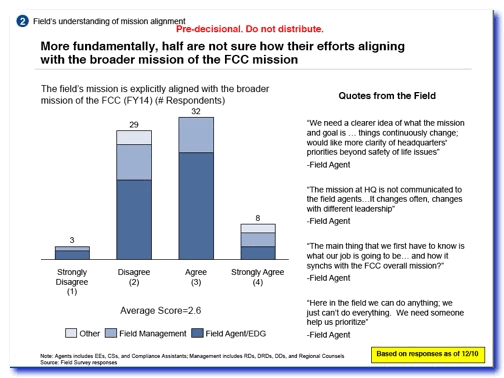
32 out of 70 EB staff respondents answers that they either disagreed or strongly disagreed with the statement "The field’s mission is explicitly aligned with the broader mission of the FCC". Is this an indication that spectrum enforcement should be downsized or a call for a major shakeup in EB leadership? For more than a decade the EB spectrum enforcement staff has been puzzled on what were the goals and priorities of the organization. Since they didn't know the goals, initiative was discouraged because you might enforce something that wasn't wanted. Look at the April 24, 2010 blog post that was here. FCC could have saved a lot of money if they had read it and acted! Here is an excerpt from hat post that indicates EB staff confusion over enforcement goals:
Sources in EB tell me that during the DTV transition when EB agents were visiting electronics retailers in large numbers to check for proper labeling on TV receivers being sold they were actively discouraged from noticing other equipment being sold that was illegal. Thus a return to the Adm. Nelson “telescope to the blind eye” approach.
Field downsizing will not accomplish anything - except maybe saving some money to be spent elsewhere in FCC - unless FCC & EB leadership take an active role in defining clear goals for field spectrum enforcement and gets adequate funding for equipment, travel and overtime: 3 things that field enforcement needs that are not needed by FCC staffers in Southwest! (As we have said before, city hall clerks need fewer resources than policemen and firemen. Does that mean that cites should downsize police and fire resources?) There is a real risk that the downsizing without strong leadership will facilitate spectrum chaos.
Indeed, the current glut of broadcast pirates may be a premonition of what is coming if FCC does not get its spectrum act together. Aviation safety may also take a big hit as the report minimizes the need for continued tower marking and lighting inspections mandated by §303(q) and gives no alternatives to assure this safety related compliance.
Think about this next time you fly!
CLARIFICATION
At no time has your blogger ever solicited internal nonpublic FCC documents from FCC staff. The first draft of the consultant report that I announced on this website was received from a known source outside FCC who sent it unsolicited. The longer document in this post was received unsolicited from a GMAIL account that is clearly a pseudonym and the cover message implied it was from an FCC employee. I have no idea who it was from and again did not solicit it, although I had requested it in my FOIA request that I believe was improperly handled at FCC. Before posting it here, I checked to make sure it contained no information affecting national security or law enforcement function or the privacy of FCC employees.. Indeed, the document's marketing do not imply it contains such material.
Vic Hayes, Founding Chair of 802.11, Inducted into Consumer Electronics Hall of Fall for Wi-Fi Development
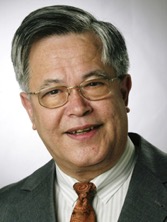
The CEA magazine i3 ("It is Innovation") published a long bio of Vic and discussion of his work that is here.
There is something really unlikely about the whole early history of Wi-Fi. Vic worked for NCR, the company once called National Cash Register because that was their main product. Except for a brief foray into PC production, NCR was never in the consumer products business and was a classic B2B firm. (It is interesting that today's NCR has no interest in discussing its role in Wi-Fi and even blocked placing a plaque commemorating Wi-Fi development in one of its buildings in Holland!)
But an interest in the 1980s to sell PC-based cash registers in department stores that could be interfaced to store main frame computers focused NCR's attention on networking. Wired Ethernet was not a practical solution in such stores due to cement floors and frequent rearrangements of counters. Thus in 1987 a search began for a wireless alternative. The group involved, located in NCR's Utrecht Holland lab quickly noticed the possibility of the May 1985 FCC spread spectrum/ISM band decision as a home for such networking.
Vic was then the founding chair of the IEEE 802.11 committee that started with a handful of members and went on to develop the ubiquitous 802.11 standards that we expect everywhere we go. Vic coauthored a book on how this all came about and I strong recommend it.
Congratulations to Vic on this well deserved honor!
Wright Case Highlights FCC's Petition Black Hole
The above snapshot of the FCC's home page today shows FCC crowing about its success in the Wright Petition case dealing with inmate call rates. While this Title II proceeding has little to do with spectrum policy it highlights the little known details about how the FCC's "petition black hole" works. The right to petition the federal government is one guaranteed by the 1st Amendment and the APA (5 U.S.C. 553(e)). FCC has implemented this requirement with 47 C.F.R. 1.401. But all this means nothing if petitions fall into an administrative black hole where they can not be seen, let alone acted on!

"These cases raise issues that are of great human concern to inmates, their family members and their counsel. . . . In referring this matter to the FCC, the Court expects the agency to move with dispatch to conclude its ongoing proceedings so as to provide both courts and parties with meaningful analysis and guidance on these issues." (Emphasis added.)
So this case was not a random petition that just wandered into the FCCs inbox, it came with the urging of a federal judge to "move with dispatch" and even then FCC frittered away years on inaction!
Petitions from techies for new spectrum rules or even waivers also can be caught in the FCC's petition back hole for years. The NPRM in Docket 13-111 on contraband cellphone use in prison accidentally gave a clue about the petition blackhole at FCC. The drafters of this NPRM had the award issue of how to deal with several petitions relating to it that had been gathering dust for years without even a request for public comments.
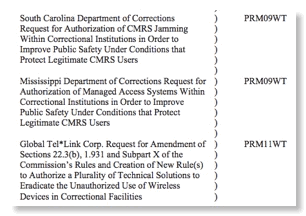
The drafters dealt with this awkward issue by identifying the petitioners with their index numbers in ECFS using a scheme that had never been revealed to the public and was not even widely known within FCC. So if you input into ECFS "PRM14WT" you get back a list of all petitions that were assigned to the Wireless Telecom Bureau, correctly or not, in 2014. There you will find that a petition from key industry player Land Mobile Communications Council was filed on 05/15/2014 and public comments were requested on 07/21/2014 as RM-11722 . But petitions from the more obscure Mark Friedlander and Cord Davidson remain in the FCC's black hole, nether having been dismissed nor having been put out for public comment.
So here is a concrete suggestion to address the root cause of the Wright Petition delay and delays of petitions lingering in the black hole: FCC should establish an online database of all petitions for rulemaking and waivers within a few weeks of their filing at FCC that identifies which bureau they have been assigned to (something that is sometimes in error) as well as stating what the current status of the petition is, e.g. without any action, dismissed, public notice requesting comments has been issued, NPRM issued, etc. FCC should also public statistics on time to resolve such petitions. So while today's commissioners decree the delay of the Wright Petition, let's make sure that never happened again in either technical or nontechnical proceedings at FCC.
ICYMI: @FCC takes a big step to reduce inmate calling rates. Details: https://t.co/4o2A10i58P
— The FCC (@FCC) October 27, 2015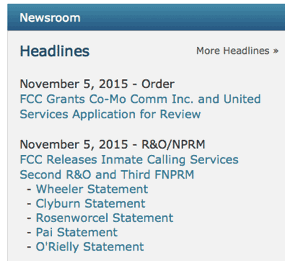



![Validate my RSS feed [Valid RSS]](valid-rss-rogers.png)

